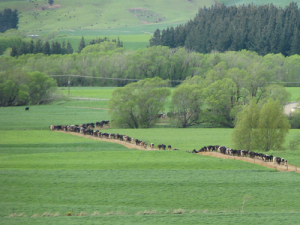Wired for Science: Understanding the feeding habits of mealybug
Fussy children might be frustrating, but fussy mealybugs could help protect the New Zealand wine industry from grapevine leafroll-associated virus 3.
 Hafiz M. Abrar Ilyas is comparing the difference between Pastoral Dairy Farms and Confined Animal Feeding Operations dairy systems in terms of energy consumption and environmental emissions.
Hafiz M. Abrar Ilyas is comparing the difference between Pastoral Dairy Farms and Confined Animal Feeding Operations dairy systems in terms of energy consumption and environmental emissions.
A Lincoln University PhD student is putting New Zealand’s vaunted paddock-based dairy industry to the test.
Hafiz M. Abrar Ilyas is comparing the difference between Pastoral Dairy Farms (PDFs) and Confined Animal Feeding Operations (CAFOs) dairy systems in terms of energy consumption and environmental emissions.
He says it is something that has not been done before but needs to be looked at if New Zealand is to take its environmental responsibilities seriously.
“Pastoral Dairy Farming Systems are common in New Zealand while the CAFO system is relatively new, but increasing in numbers especially in the South Island,” he says.
“The core advantage of using CAFOs system is that they have minimum soil disturbance, have more control over climate events and research has shown they can achieve higher milk production per cow.”
However, are they more energy efficient and able to reduce emissions?
A direct comparison will let the numbers speak for themselves.
“The intensification of New Zealand’s dairy industry, including its vertical and horizontal expansion could cause serious environmental issues,” Ilyas says.
New Zealand’s agriculture sector produces 46% of its greenhouse gas emissions, according to a 2014 Ministry for the Environment report.
Dedicated efforts and studies are required to look into the environmental impact the dairy industry is having on New Zealand, he says.
“The findings of this study can be useful for making environmental policy regarding NZ dairy production systems as well as help farmers in selecting appropriate farm management practices for the sustainability of the New Zealand dairy industry."
A qualified engineer, he is being supervised by Dr Majeed Safa and Professor Alison Bailey and will be surveying farmers using both systems, and hopes to have results in June, 2017.
The National Wild Goat Hunting Competition has removed 33,418 wild goats over the past three years.
New Zealand needs a new healthcare model to address rising rates of obesity in rural communities, with the current system leaving many patients unable to access effective treatment or long-term support, warn GPs.
Southland farmers are being urged to put safety first, following a spike in tip offs about risky handling of wind-damaged trees
Third-generation Ashburton dairy farmers TJ and Mark Stewart are no strangers to adapting and evolving.
When American retail giant Cosco came to audit Open Country Dairy’s new butter plant at the Waharoa site and give the green light to supply their American stores, they allowed themselves a week for the exercise.
Fonterra chair Peter McBride says the divestment of Mainland Group is their last significant asset sale and signals the end of structural changes.
President Donald Trump’s decision to impose tariffs on imports into the US is doing good things for global trade, according…
Seen a giant cheese roll rolling along Southland’s roads?